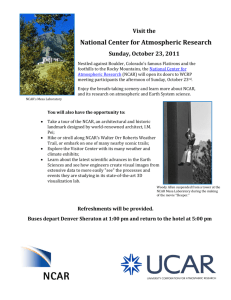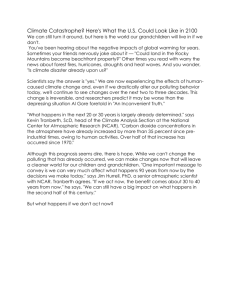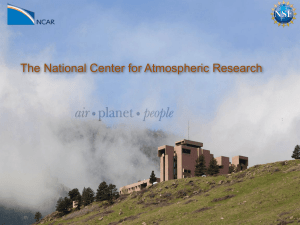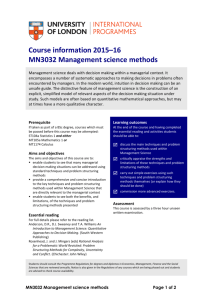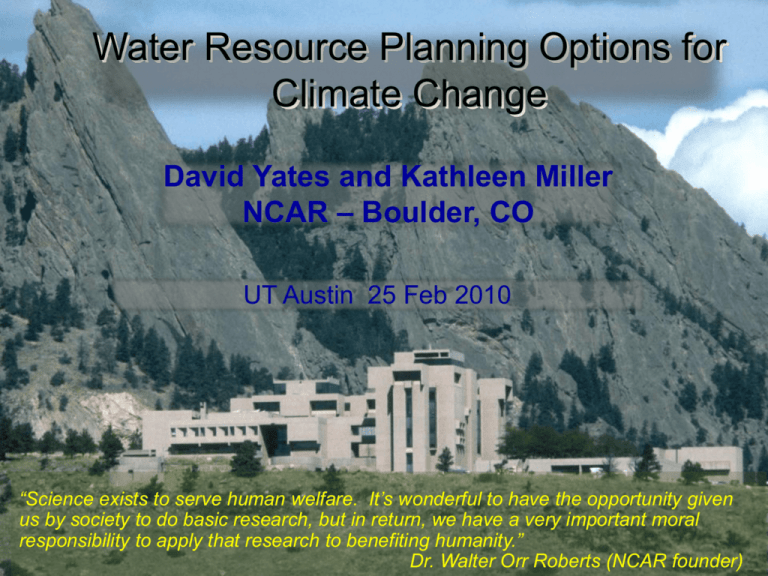
Water Resource Planning Options for
Climate Change
David Yates and Kathleen Miller
NCAR – Boulder, CO
UT Austin 25 Feb 2010
“Science exists to serve human welfare. It’s wonderful to have the opportunity given
us by society to do basic research, but in return, we have a very important moral
responsibility to apply that research to benefiting humanity.”
Dr. Walter Orr Roberts (NCAR founder)
Warming accelerates the hydrologic cycle
Surface temperature
Evaporation
Water holding capacity
Atmospheric moisture
Enhanced Greenhouse
Rain intensity
Rain frequency
Floods
&
?
Droughts
Water Resource Impacts
Most likely:
Global precipitation ↑~ 1- 2% per 1oC
Snow season shorter→ earlier peak flow
Glacial wastage → summer flow ↑ near-term, but ↓
long-term
Sea level rise → saltwater intrusion, coastal flooding
Intense precipitation → water quality impacts
GCM’s – A Grid of Points over Earth
(Precipitation is the most difficult modeled variable)
Typical global climate model has
1-2 million calculation points
UCAR Confidential and Proprietary. © 2008, University Corporation for Atmospheric Research. All rights reserved.
Climate Models circa early 1990s
Global coupled climate
models in 2006
Global models in 5-10 yrs?
Regional models
Adaptation – an ongoing process
First steps can be taken now
We know that:
What can we do?
Global climate change may
substantially change water
supply and hazard
characteristics
It will create new uncertainties
for water policy and planning.
Develop tools to incorporate
climate change information
Risk management approach
to water resource policy and
planning – Engage
stakeholders
Need “Actionable Information”
David Behar, Water Utility Climate Alliance, “We need actionable
information to make changes or additions to capital investments..”,
San Francisco Public Utilities
Marc Wagee, Manager of Water Supply, Denver Water, “Surprisingly,
we haven’t dealt well with uncertainty.. Climate change is a wake-up
to this fact”
MWRA and the “Boston Harbor Cleanup”,
12
Study Approach
Developing Decision Analysis tools that
incorporate climate change information
Risk-management approach to decision-making
Worked with a set of water utility partners from the
very start
Portland
MWRA
CO SPRINGS
IEUA
PALM BEACH
COUNTY
Partnership Design and Decision
Tools
Industry Research –
AwwaRF
Utility
Partners
Structured Process
& Decision Tools
Project Team
NCAR,
consultants
Climate Research – NCAR;
Universities; Federal Agencies
Partnership Design and Decision
Tools
Problem
Structuring
• Problem
Structuring
• Goals
Industry Research –
AwwaRF
Colo
Springs
Utilities
WEAP, MODSIM
Project Team
NCAR, MWH
Climate Research – NCAR;
NOAA, U. of Colo
NCAR
Top Down Vs. Bottom Up
Emission and Climate
Scenarios
Global Climate Models
Regionalization
Impacts
Vulnerabilities
Climate Adaptation
Policy
Vulnerability
(physical/social)
climate variability
and change
Adaptive Capacity
Reliability Equity
Economics
Institutions
Technology
Infrastructure
Climate Change Assessments in
Water Planning – Top Down
Jamie Anderson, Ca DWR, 2008
Bottom-Up Approach: Decision
Analytic Approach to Climate Change
Problem
Structuring
Deterministic
Formulation
Uncertainty
Analysis
Evaluation of
Alternatives
• Problem
Structuring
• Goals
• Decision Model
• Sensitivity Analysis
• Probabilistic
Representation
• Future Projections
• Robustness
• MCDA
• EV
• Triple Bottom
Problem
Structuring
PROBLEM STRUCTURINGGOALS AND OBJECTIVES
• Problem
Structuring
• Goals
Inland Empire Utility Agency
Focus on enhancing local supplies or rely on imports?
Colorado Springs Utilities
Integrated Resource Plan… how to link to current safe yield analysis?
MWRA
Safe Yield Analysis- What level of demand meets Quabbin storage targets
under climate change
Palm Beach County
IRP in the face of major changes (Lake Okeechobee, future demand, environ
interests, sea level rise, climate change, etc.)
Deterministic
Formulation
Deterministic Formulation
• Decision Model
• Sensitivity Analysis
• This Approach is Model-based: “All are wrong,
Some are Useful”
• Surprisingly, many water utility models are not
“climate-enabled”
• Develop approach that can address the questions at
hand: “Keep it simple as possible, and no simpler”
• Begin Climate Change Exploration
Need for An Integrating
Model Framework
Deterministic
Formulation
• Decision Model
• Sensitivity Analysis
Pre-development
Temp, rh, wind
Natural Watershed
Developed Watershed
Water imports
Hydrology Model
Deterministic
Formulation
• Decision Model
• Sensitivity Analysis
Critical question: How does rainfall on a catchment translate
into flow in a river?
Critical question: What pathways does water follow as it moves
through a catchment? Runoff? Infiltration? ET? Seepage?
Critical question: How does movement along these pathways
impact the magnitude, timing, duration and frequency of river
flows?
Planning Model
Deterministic
Formulation
• Decision Model
• Sensitivity Analysis
Critical question: How operations be optimized to protect the
services provided by the river?
Critical question: How should infrastructure (e.g. dams,
diversion works, etc) be operated to achieve maximum benefit?
How should water be allocated in shortage?
Critical question: How will allocation, operations and operating
constraints change if new management strategies are introduced
into the system?
Water Management Can Get
Complicated
Integrated Water Resource Management
• Integrates hydrology and water planning model
• GIS-based, graphical GUI interface.
• Physical simulation of water demands and supplies.
• User-created variables and modeling equations.
• Scenario management capabilities.
• Seamless watershed hydrology, water quality and
financial modules
• SEI-US.org, NCAR, Wat Res Fnd, USEPA
•
Yates et al. 2005, Water International, Pt. 1 and Pt. 2
Evaluation of
Alternatives
• Robustness
• MCDA
• EV
• Triple Bottom line
Case Studies
Colorado Springs, CO
Palm Beach County, FL
Boston, MA
Inland Empire of Southern CA
Portland, OR
Durham
El Dorado Irr District
Portland
EID
IEUA
MWRA
CO SPRINGS
Durham
PALM BEACH
COUNTY
CSU’s Water System
• 75% of our water comes
from reservoirs near the
Continental Divide, over
200 miles away
• 25% of our water comes
from Pikes Peak and the
Arkansas River
• Winter snows provide a
continuous fresh water
source for the citizens of
Colorado Springs
75% from West Slope
25% from East Side
Diversion Rights are Largely Controlled by Senior Rights on Colo River
at Cameo and Shosone
30
Deterministic
Formulation
• Decision Model
• Sensitivity Analysis
+
Watershed
Pour Points
Sub-watersheds
A. Sub-watershed Delineation
4
3
2
1
Sub-watersheds
12
50
m
10
00
m
75
0m
50
0m
+
Elevation Bands
Catchments
B. Elevation Banding
04
04
04
04
_1
_1
25
00
_0
7
_0 50
50
0
0
0
02_1250
02_1000
02_0750
01
02_0500
01
03_0500
03_0750
03_1000
03_1250
01
01
_0
_0
50
_1
75
0
0
C. Final Catchments
_1
00
25
0
0
Characterization
of Watersheds
and SubWatersheds
NCAR and CSU built a WEAP Application of West Slope Supply
Watersheds are defined according to Elevation Bands
with a unique climate forcing dataset.
The WEAP Application-Some Details
• Rivers and Creek (11+)
– Blue, Ten Mile, Eagle, Homestake, Williams Fork, Fraser, Willow,
Roaring Fork, Frying Pan, Muddy, Arkansas
• Reservoirs (10)
– Granby/Grand, Dillon, Green Mountain, Homestake, Meadow Crk,
Ruedi, Upper Blue, Williams Frk, Windy Gap, Wolford
• Diversions and Rights (12)
– Grand River, CBT, Windy Gap, Willow Crk, Moffatt, Jones Pass, Roberts,
Hoosier, Homestake, Boustead, Hunter, and Twin
• Major Diversion Rights which Influence CSU
– Hoosier, Homestake, and Fry Ark. These are controlled by the
Shoshone and Cameo Calls.
– Green Mountain Payback
– Representation of CBT and Denver Water’s “Rights”
Calibration Objectives: Re-create observed
flow, storage, and delivery for historic period
Streamflow
Cameo Weekly Avg flow
* Statistical evaluation will be available in Water Research Foundation Report
Monthly Average Storage
* Statistical evaluation will be available in Water Research Foundation Report
Only Simple Climate Sensitivity thus
far
• Add 2.8oC to complete historic temperature- DT2.8
• Add 2.8oC and reduce precip. By 10% - DT2.8-10%
Blue River inflow to Dillon
*28-year monthly mean, (1000’s a-f)
Colorado at Cameo
Storage, Delivery and Diversion:
Homestake
Storage (weekly average, 1000’s a-f)
Homestake Diversions (weeks)
June, July, August
DT2.8
Delivery
June, July, August
DT2.8-10
PBCWUD
Problem
Structuring
Kissimmee
HeadwatersRapid Urbanization
• Problem
Structuring
• Goals
Shallow Freshwater LakeReoperated for Flood Control
Largest Sugarcane region in Floridasome interest in ‘buying out’
Preservation of Wetland Habitat
Urbanizing Corridor
Inland Estuary- Freshwater flux to
tide
NCAR
Problem
Structuring
Deterministic
Analysis
PBCWUD: Goal or Question:
Is there a “Robust” Capital Improvement Plan?
Uncertainty
Analysis
Evaluation of
Alternatives
iterations
20-Year CIP Projects:
• ASR wells
• Surface Storage
• Water and WWTP
Expansions
• New RO Treatment Facility
• Wellfield Expansions
• New Deep Injection Wells
NCAR
WEAP Supply-Demand Model
Rigorous Representation
Problem
Structuring
Deterministic
Analysis
Uncertainty
Analysis
Evaluation of
Alternatives
iterations
NCAR
Problem
Structuring
Deterministic
Analysis
Uncertainty
Analysis
Evaluation of
Alternatives
iterations
WEAP Model- Model of Supplies
Lake Okeechobee
Storage
Kissimmee Inflows
obs
simulated
C-51 Outflow
19.0
18.0
g
b
c
d
e
f
b
c
d
e
f
g
17.0
16.0
15.0
14.0
Lake Level
HistoricElev
obs
simulated
13.0
12.0
ft
11.0
10.0
9.0
8.0
7.0
6.0
5.0
4.0
3.0
2.0
observed
simulated
1.0
0.0
May Feb Dec Oct Aug Jun Apr Feb Dec Oct Aug Jun Apr Feb Dec Oct Aug Jun Apr Feb Dec Oct Aug Jun Apr Feb Dec Oct Aug Jun Apr Feb Dec Oct Aug Jun Apr Feb
1969 1970 1970 1971 1972 1973 1974 1975 1975 1976 1977 1978 1979 1980 1980 1981 1982 1983 1984 1985 1985 1986 1987 1988 1989 1990 1990 1991 1992 1993 1994 1995 1995 1996 1997 1998 1999 2000
NCAR
Problem
Structuring
Deterministic
Analysis
Uncertainty
Analysis
Evaluation of
Alternatives
iterations
Population: An Uncertain Future in South Florida?
PBCWUD Total Demand in 2008 - ~80 MGD
Regional Demand in 2008 - ~ 225 MGD
NCAR
Problem
Structuring
Deterministic
Analysis
Uncertainty
Analysis
Evaluation of
Alternatives
iterations
Climate Scenarios- Spatial-Statistical Downscale
NCAR
Problem
Structuring
Deterministic
Analysis
Uncertainty
Analysis
Evaluation of
Alternatives
iterations
Microsoft Excel,
MCDA DashboardExplore Uncertainties
MCDA (Excel) used to
set parameters
WEAP
• Population Growth Scenario
• Water Use Rate (gpcpd)
• Climate (Historic or Model)
• Regulation
NCAR
MCDA
Problem
Structuring
Deterministic
Analysis
Uncertainty
Analysis
Evaluation of
Alternatives
iterations
Stakeholder Weights Assigned to Each Criteria
Each Criteria is Evaluated for Each Alternative
NCAR
HOW? Then Use Model to Evaluate Alternatives
Focusing in on an Alternative: Modified CIP + C51
WEAP Mathematical “Expression Builder” is used to mimic the
operations of C-51, e.g. Fill during high flows, release during low flows
C-51 Storage
inception
Dry Period
NCAR
Example Results – C-51 Reservoir
Monthly Mean Discharge, 2023-2030 (Historic climate ‘repeats’)
Storage in wet period,
Decrease in discharge
Release in dry period,
Increase in Discharge
D2S2 Helping Water Manager Plan for the Future
NCAR
http://www.isse.ucar.edu/awwarf/
http://waterresearchfoundation.org/
http://sei-us.org
http://weap21.org
David Yates yates@ucar.edu
Kathleen Miller kathleen@ucar.edu

